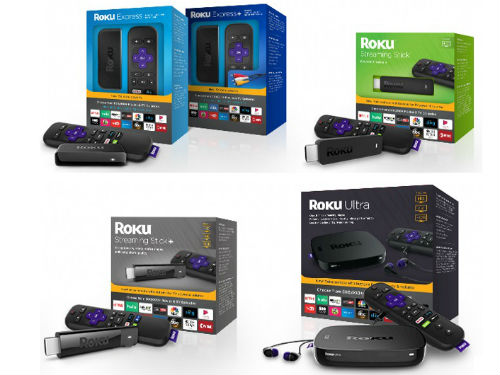Roku Freshens Up Streaming Device Lineup, Bows New OS

Fresh off a successful IPO, Roku has broadened its streaming player lineup and complemented it with a new, more capable operating system for devices and integrated Roku TVs amid heated competition with rivals such as Amazon, Apple and Google.
RELATED: Roku Rises in Nasdaq Debut
On the device side, Roku said it’s aiming to reach a full spectrum of consumers with low-, mid- and high-end devices that include those for people who are new to streaming or have secondary TVs in the home, to people who require 4K and HDR capabilities alongside a mix of other bells and whistles.
Roku’s new lineup comes ahead of the holiday buying season and soon after rivals Amazon and Apple introduced new models of their own.
RELATED: Amazon Sparks Fire TV With 4K and HDR
Here’s how Roku’s new device lineup stacks up:
-Roku Express and Roku Express+: Representing a more powerful, second generation on Roku’s lower end, the HDMI-connected Roku Express sells for $29.99, while the Roku Express+, offered exclusively at Walmart, supports HDMI and composite A/V ports (for older TVs without HDMI ports), for $39.99. Though the price on those models hasn’t changed from the first-gen versions, the new products pack five times the processing power, according to Lloyd Klarke, Roku’s director of product management.
Multichannel Newsletter
The smarter way to stay on top of the multichannel video marketplace. Sign up below.
-Roku Streaming Stick and Roku Streaming Stick+: Both models feature quad-core processors and 802.11 AC dual-band MIMO wireless. The baseline, HD-capable Roku Streaming Stick sells for $49.99 MSRP, while the new Roku Streaming Stick+, which goes for $69.99, features a wireless receiver that’s built into the power cord and supports 4K and HDR video formats and streaming up to 60 frames per second.
In addition to bumping performance, the new steaming sticks will include remotes that support voice input, and the ability to control the TV’s power and volume controls, Klarke said, adding that the new the new sticks essentially replace the Premiere and Premiere+ (introduced last fall) in Roku’s lineup.
Thanks to their compact form-factor, Klarke noted that 59% of Roku streaming stick owners use it in multiple rooms, and 36% have used it out of the home.
-Roku Ultra: The top-end of Roku’s streaming lineup also packs in advanced wireless, 4K and HDR capabilities, plus an Ethernet port and a micro SD slot, for a reduced price of $99.99 (down from the $129 price point introduced last year). The Ultra also includes a remote with a headphone jack for private listening and a remote finder button.
Roku said the new lineup is available for pre-order today from its own site, as well as Walmart, Best Buy, Amazon and other retailers, and is expected to be in stores around Oct. 8.
RELATED: Apple Intros Apple TV 4K
Roku Ready to Roll OS 8
Alongside the new device lineup, Roku also introduced OS 8, a platform that will be rolled out to players but also optimized for integrated Roku TVs.
Among the new features, OS 8 will enable consumers to use their voice to command and control Roku TVs, as well as a more integrated support of video that is streamed or obtained over-the-air with an antenna, explained Shubhada Hebbar, Roku’s VP of product.
Voice controls for Roku TVs can be used with Roku-made remotes with built-in microphones or via the free Roku app for iOS and Android devices.
The new OS’s “Smart Guide” for Roku TVs integrates and displays what’s on via OTA (up to 14 days’ worth of TV programming) and OTT, while also implementing search results from both sources. It also includes a “More Ways to Watch” component that lists out various options for how a show or movie can be accessed on the platform.
While some of the new features of OS 8 center on Roku TVs and are tailored for cord-cutters, the new operating system also tacks on features for users who get a traditional pay TV subscription.
For example, Roku OS 8 adds a TV Everywhere single sign-on element that will initially support about 30 TVE apps that are authenticated by MVPDs such as Dish Network, Cox Communications and AT&T. Roku initially has teamed with Adobe for the new SSO component, the company confirmed.
The new operating system also features a redesign of the Roku 4K Spotlight Channel.
Roku plans to start rolling out OS 8 on Roku players in early October and to Roku TV models starting in November. The company expects to complete the rollout by year-end.
Business Update
The bulk of Roku’s revenue currently comes way of sales of streaming players, with the balance from its Platforms business, which includes advertising, subscription revenue sharing, and licensing fees from TV makers that have integrated Roku’s OS (its TV partners include RCA, TCL, Element Electronics, Hitachi America, Haier America, Sharp, and Insignia/Best Buy).
RELATED: RCA Rolls out Roku TV Models
The majority of hours streamed on Roku’s platform (6.7 billion hours during the first six months of 2017) is of subscription-based content, but the company envisions that it will need to deliver “significantly more ad-supported” content to materially increase the monetization of its platform.
Roku also disclosed that it had 15.1 million active accounts by the end of Q2 2017, up from 10.6 million in the year-ago quarter.
